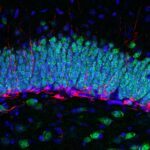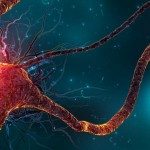To escape predators or to acquire rewards, animals need to anticipate movements. How does the brain accomplish this task? Scientists at the Institut Pasteur have recorded the activity of neurons in the frontal cortex of mice that were trained to run towards rewards. They find that seconds before the mice start running, neurons show increasing “ramps” of activity.
For every movement you consciously decide to make, your brain must process information from many different sources before it puts its plan into action. This involves fine control of many parts of the body, which must be precisely coordinated. How do the brain’s networks perform this impressive task? “The frontal cortex is a brain region that is involved in the planning of motor behavior.” explains Christoph Schmidt-Hieber, head of the Neural Circuits for Spatial Navigation and Memory Lab at the Institut Pasteur. “Brain cells in this region are thought to integrate information arriving at their input structures, the synapses, until a threshold level is reached that will then trigger motor action. However, the fundamental basis of this phenomenon – how synaptic inputs from different sources are processed preceding movement onset – has remained enigmatic.”
Using virtual reality to observe the synaptic information processing
To answer this question, the scientists were faced with the challenge to record synaptic inputs in frontal cortex neurons of behaving animals. Chun-Lei Zhang, first author of the study, cracked this problem by combining electrophysiological recordings with goal-directed tasks implemented in a virtual-reality environment for mice. He explains: “We use an electrophysiological technique termed `patch clamp`. It allows us to measure the synaptic inputs that individual neurons in the frontal cortex are receiving while mice run for a reward in a virtual-reality environment.” Using this combination of techniques, the scientists find that in untrained animals, neurons show very slowly increasing ramps of activity that precede the onset of running by several seconds. Surprisingly, these activity ramps depend on the training state of the animal. Learning the goal-directed reward task accelerates these signals. “To understand how different elements of the neuronal network contribute to this phenomenon, we combined computational modelling with inactivation of specific neurons in the frontal cortex,” Chun-Lei Zhang explains. “This strategy allowed us to uncover how the different elements of the circuit contribute to the ramping signal.”
The neuronal basis of motor decisions
These findings represent an essential piece to the puzzle of how neuronal activity in our brains drives goal-directed motor action. By unravelling the different components that contribute to ramping activity in the frontal cortex, this study sheds new light on the neuronal basis of movement planning. “The characteristic activity that we observe during movement preparation may represent a more general anticipation signal that occurs whenever a stimulus reaches conscious perception and becomes available for behavioral decisions,” Christoph Schmidt-Hieber speculates.
This work was supported by grants from the ERC (StG 678790 NEWRON to C.S.-H., MSCA 800027 FindMEMO to M.A., Human Brain Project SGA2 785907 to J.-P.C. and F.K., and Human Brain Project SGA3 945539 to J.-P.C.), the Pasteur Weizmann Council (C.S.-H.), the INCEPTION program (Investissement d’Avenir grant ANR-16-CONV-0005 to C.O.), and a Pasteur-Roux fellowship to M.A..
Source:
Inhibitory control of synaptic signals preceding locomotion in mouse frontal cortex, Cell Reports, November 23, 2021, https://www.cell.com/cell-reports/fulltext/S2211-1247(21)01517-5
Chun-Lei Zhang1, Fani Koukouli2,3, Manuela Allegra1, Cantin Ortiz1,4, Hsin-Lun Kao1, Uwe Maskos2, Jean-Pierre Changeux5,6, Christoph Schmidt-Hieber1
1 – Institut Pasteur, Université de Paris, Neural Circuits for Spatial Navigation and Memory, F-75015 Paris, France
2 – Institut Pasteur, Université de Paris, CNRS UMR 3571, Integrative Neurobiology of Cholinergic Systems, F-75015 Paris, France
3 – Institut Du Cerveau-Paris Brain Institute-ICM, Sorbonne Université, Inserm U1127, CNRS UMR 7225, F-75013 Paris, France
4 – Sorbonne Université, Collège Doctoral, F-75005 Paris, France
5 – Institut Pasteur, Université de Paris, Department of Neuroscience, F-75015 Paris, France
6 – Collège de France, F-75005 Paris, France







